GEORGE TRAGEDY
What is known about Erf 15098, Victoria Street in George, the site of the deadly building collapse
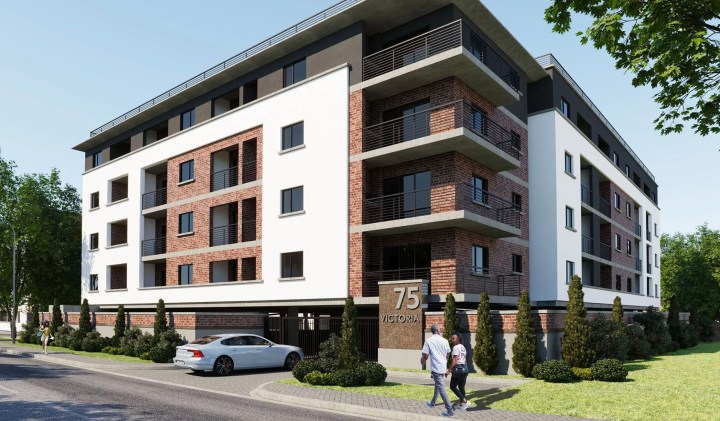
Many are seeking answers to who might be responsible for the collapse of a George building. Here’s what we know so far about the development that promised two-bedroomed apartments at R1.7-million with occupation from 1 August.
Twenty-four hours after a multi-storey, partially built block of flats collapsed on Monday, 48 people remained unaccounted for while six are confirmed dead.
The building was due for completion and occupation on 1 August before the tragedy occurred on 6 May 2024 around 2.30pm. Seventy-five people were employed on the site.
Emergency teams and various services were at the scene in Victoria Street on Tuesday in a frantic attempt to recover the artisans who remained entombed. At least 23 workers have been rescued so far.
The South African Police Services (SAPS) cordoned off the precinct and declared it a crime scene, while engineers, forensics and other experts attempted to piece together what led to the shocking implosion.
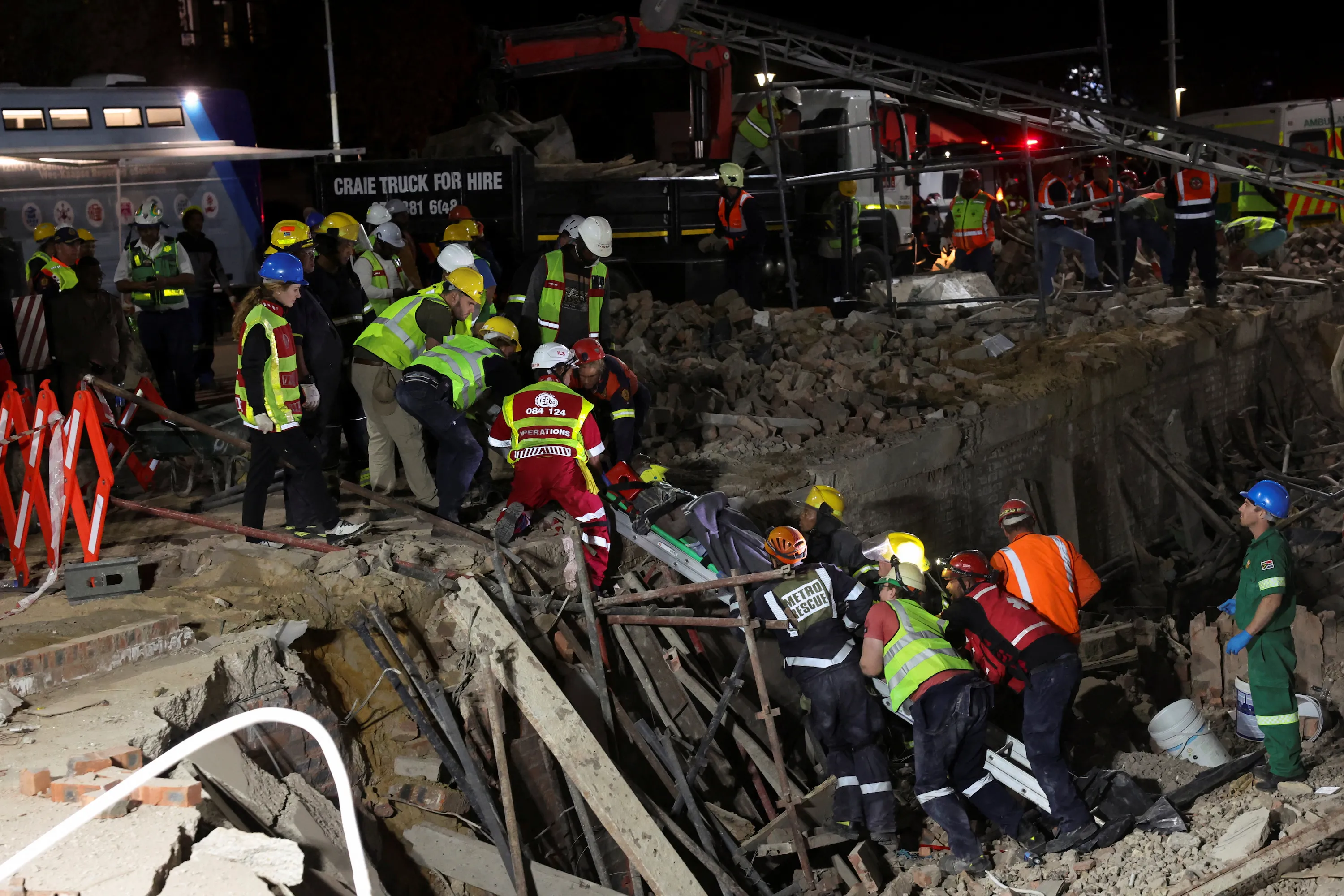
Rescuers carry a person on a stretcher as they race to save construction workers trapped under a building that collapsed in George. (Photo: Reuters / Esa Alexander)
History of Erf 15098
While many are seeking answers as to who might be responsible for the tragedy, it will take months to determine what exactly went wrong and who will be held to account.
What we do know or what is in the public realm is the history of the development of what was to be simply called “75 Victoria”, as records were filed with the George Municipality. These are part of municipal records accessible to the public.
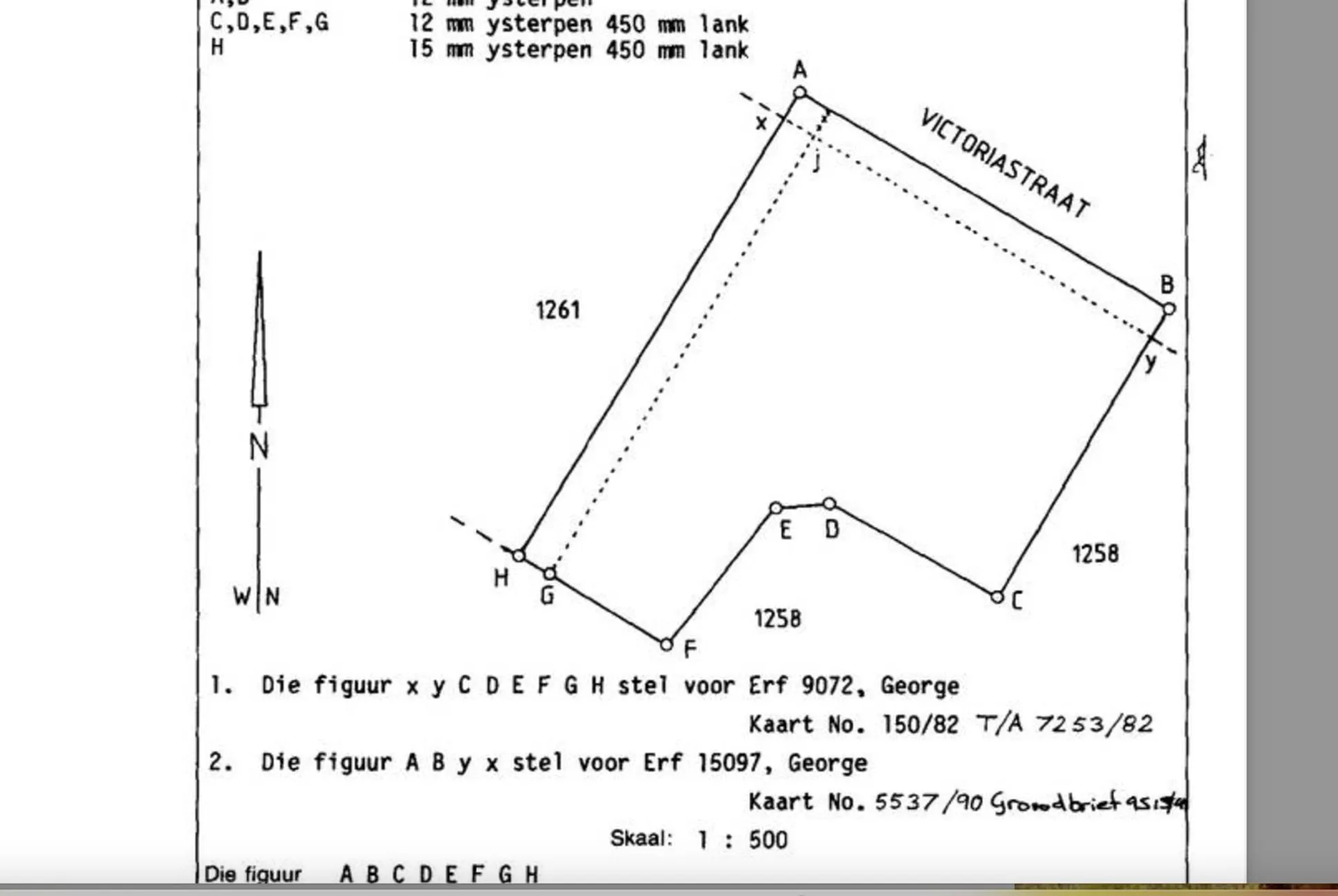
The erf as attached to proposals submitted to the George Municipality in November 2020. (Image: Supplied)
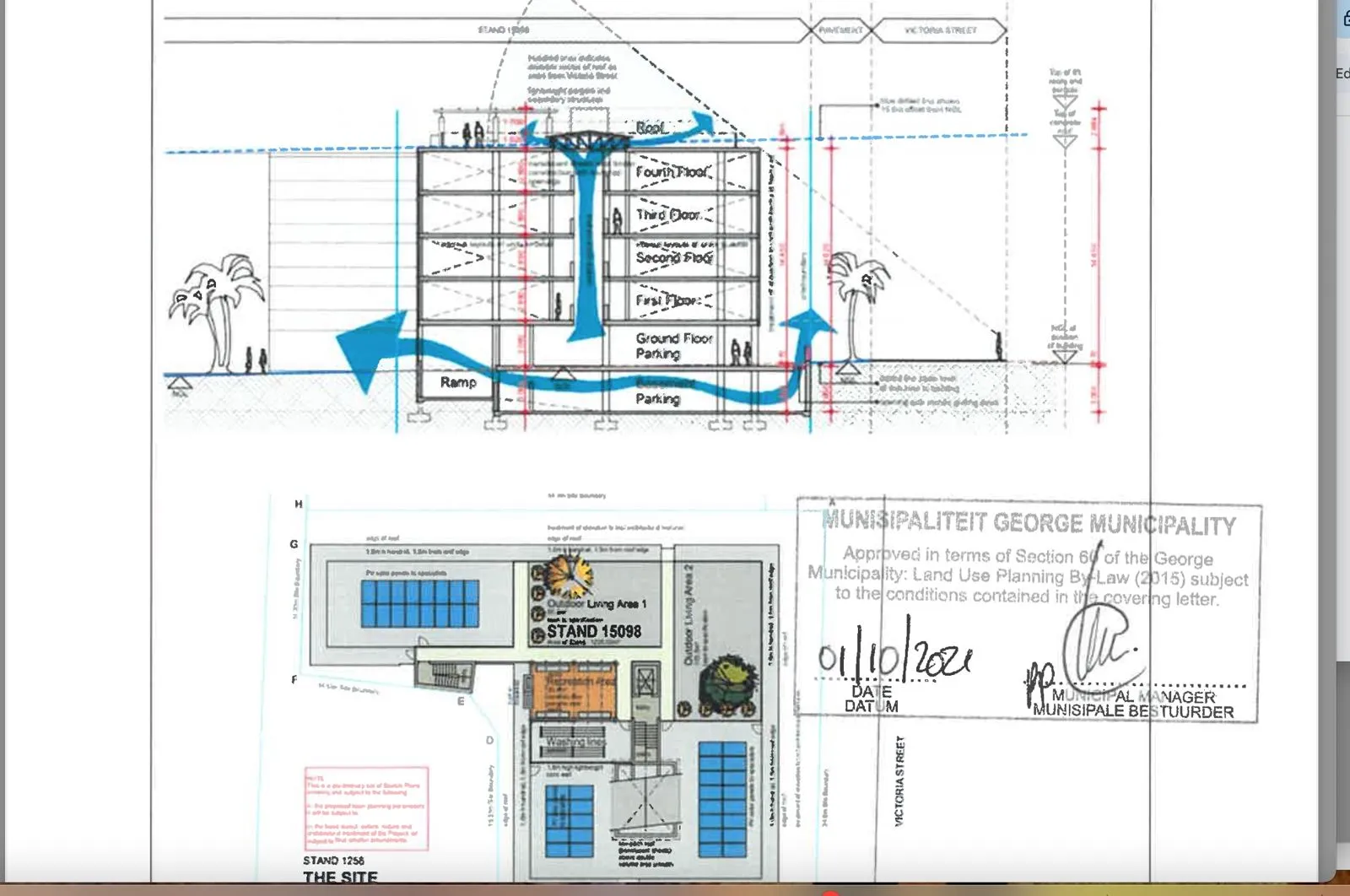
The January 2021 plan from the rezoning application as approved by the municipality. (Image: Supplied)
In August 2020, the owner of a 1,228m²plot of land, Erf 15098, located on Victoria Street, sold the property for R2.07-million in a private sale to a company, Pacific Breeze Trading 91, registered with the Companies and Intellectual Property Commission as being in the business of “general trading in all aspects”.
The deal was finalised on 4 November 2020, according to the Deeds Office. Directors of the company are Anton Booysen, Carel Swanepoel and Annette Swanepoel. Pacific Breeze was registered in 2005.
In November 2020, the George Municipality held a “pre-consultation” meeting with an official, Ilane Huyser, and town planner Jan Vrolijk, as the “pre-applicant” for rezoning and deviations for the planned development.
Records show that applications were made by the owner, through Vrolijk, who was given power of attorney by Swanepoel, for changes to the original plans. These included an extra level, turning an original three-storey plan into a four-storey block, as well as adding basement parking.
Earlier, in September 2020, a Land Use Planning Pre-Application Consultation Form had been completed and was re-submitted at the November meeting with the municipality.
Discussions then were about rezoning as well as various deviations, including building line relaxations, height, coverage, floor space and parking requirements.
Pacific Breeze proposed including basement parking, that the building be increased from four to five storeys to include ground-floor parking, over and above the basement parking.
The building would be 14.45m tall and a roof garden (2.72m high) was proposed, which would raise the height to 17.17m.
The proposal also contained 66 parking bays with a ratio of 1.25 per unit and 0.25 per visitor, which would be housed in the basement. There were also proposals for the adjustment of building lines.
Approval
On 1 January 2021, Vrolijk was informed by Clinton Petersen, senior manager of town planning in the George Municipality, that the application for various changes had been approved.
Reasons included that “the subject properties are located within walking distance from public transport facilities (“bus stops”) and supports the efficiency of public transport systems and transport-orientated developments”.
In addition, the development “would provide for much-needed housing opportunities”, it “supports densification in strategic areas” and it would not have an adverse impact on adjacent neighbours.
“The development can thus be deemed compatible with the spatial planning policies and guidelines for the area.”
Petersen then set out the conditions of his directorate and stated that because of the changes, “development charges” totalling R1,533,848.06 would have to be paid to the municipality by the developer. The plans, Petersen added, would still have to be submitted for approval.
In March 2021, Vrolijk, on behalf of Pacific Breeze, applied for the development’s number of floors to be increased from “four to five”.
The same month, a local conveyancer certified that the title deeds contained “no conditions restricting the contemplated land use in terms of the Land Development Application”.
Apartments were originally pre-advertised for R 1.7-million for a two-bedroomed unit by one agent in the area, with the beginning of construction earmarked for 1 April 2023, completion on 31 March, with 1 May 2024 as the occupation date.
The development, it was later announced, would be completed by July 2024 with occupation in August.
Legal contractor
George Mayor Leon van Wyk told the George Herald on Tuesday that the developer on the project was the Neo Trend Group Ice Project, which had submitted plans in December 2022, which had been approved in July 2023.
Theuns Kruger, director of the contracting firm, Liatel Developments, said the company would offer full cooperation with SAPS and was assisting with ongoing rescue efforts.
On the website for the Mussel Creek development, Kruger describes himself as a “practising attorney with vast experience in commercial and construction law”.
He adds that he has practised for his own trust account for the past 14 years and that his company was formed in 2009 “with the purpose to be a vehicle to assist and consult on various property and commercial developments”.
This included “various legal aspects associated with management, but also includes assistance with the administration and financial associated with construction and developments”.
The Western Cape government has since appointed an engineering firm V3 to investigate what led to the collapse of the building. DM






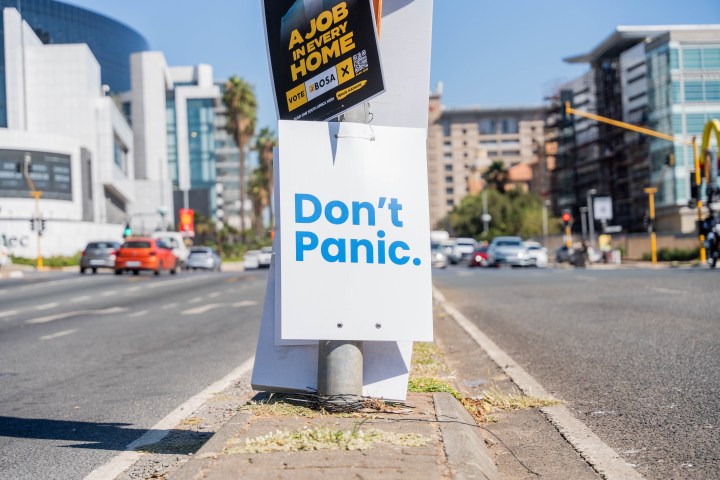








The plan for 4 floors was initially submitted and approved, obviously with construction material covering the length and weight of such a building.
Then the plans were amended and approved to add a fifth floor an increase in weight and length.
I am not an engineer.
I fully agree, I also think that this is where the lies.
The information detiles is the Town Planning/ Zoning submission – the “Site Development Plan”.
Strength of design and structure would be on the building plans submission, which would have been subsequent to the town planning
This is very sad
The competency of the building contractor and the credentials thereof… For example the CIDB grade, what was approved as the building plan.. Health and Safety assemennts continuously.. What was the baseline risks assessment.. There seems to be a lot not coming hope the investigation will shed a light for lessons learnt and accountability
CIBD grading requirements is only applicable in public Infrastructure procurement, in the private sector build environment companies & consultants are a law unto them themselves.
Hence the reason for no transformation in the sector, as they only employ of their own ethnic group, without requirements of track records, extertise or any functionality criteria before appointment. George & the wider region saw the traditional hub of coloured construction firms being decimated by these start-ups from up North, the George municipality boasted earlier this year that building plans for projects of more than a billion rands were approved year-on-year since 2019.
These types of developers & contractors are mushrooming on our area enjoying the boom whilst killing off local construction industry.
Even in the public sector only 2 or 3 of these firms are controlling the infrastructure soend in the region, reducing former black contractors to bakkie builders & labour-only contracting.
That’s the PPP (Public Private Partnerships the DA is so proudly promoting)
Very sad and tragic situation. Each individual and families remain in our Prayers.
This is a very sad situation.
Two possibilities for the collapse come to mind: firstly, adding the weight of an extra floor was not included in the strength calculations for the concrete supporting structure; secondly, poor quality cement was used in that concrete (and the concrete cube strength tests weren’t done properly). Just thinking, but I obviously totally agree with the comments above as well. How awful for the relatives (and how fantastic the Gift of the Givers prove to be yet again – along with the municipal workers of course).
Or they didn’t install the reinforcing properly or they took the supports away too soon. It will be interesting to see the final report.
Neither of your proposals would normally happen. Builders really aren’t that stupid no matter what you might think.
Removal of props before the lower floors cured, or insufficient support on lower floors is the most likely suspect here given the collapse.
I tend to agree
The poor concrete hypothesis is compelling. I vaguely remember reading a few months ago about a concrete recall owing to substandard (likely imported, re-bagged) product.
We keep all families affected this tragedy in our prayers
I am sure we will learn the truth soon enough and trust the guilty parties will be made to account.
It went from a 3 to a 4 then a 5 story with a basement added…herein lies the answer from a lay perspective.
What level had been reached by constructors when the structure collapsed?
This is a major tragedy for construction, our offices had a moment of silence for our floor meeting yesterday. Our line of work does not come without risks, but somewhere someone made a mistake. Not with maliscious intent hopefully and also not gross neglagence. The building plans changing muptiple times in a short period could be the reason behind it, but not due to incompetence, due to stressful work conditions, if a structural engineers team is put under pressure to produce plans due to them changing it could lead to something that is missed, all the blame can not be pointed at the engineer. I hope this was not the case. We’ll wait for the report and all prayers for the families.
Nothing controversial in the plans, only story……. So bad construction clearly, maybe materials, maybe no approved regularly by the building inspectors or ?
I think you are correct Geoff. Story of the day quotes Ģeorge Mayor Van Wyk said. He added that the developer had hired a professional team, which included contractors, surveyors and engineers.
“The municipality would then come back when the building is completed and issue an occupancy certificate for the building to be occupied.”
I think van Wyk put his foot in it there.
Building inspectors should be on site for periodic building checks – from the digging of and then casting of foundations through out the building process.
The municipality should be making regular visits but they are not qualified to check the design and construction. Engineers are appointed to do this and must certify that the materials and methods used are correct. Normally samples of concrete must be done and tested at every stage of construction. Before concrete is poured, the reinforcing has to be checked and signed off. I suspect we will find that short cuts were made in order to save costs with fatal consequences. Having said that, let’s not prejudge and let’s wait for the results of the investigation.
Spot on!
An architect’s view: The time-line here doesn’t suggest a rush to get onto site; the additional floors were part of the town planning submission, before the working drawings would have been produced, so I doubt the engineer’s would have been under time pressure. I think we’ll discover the problem had to do with support (propping) of concrete slabs, where the top floor shuttering was either inadequately support and caved during the concrete pour, or the props were removed too early, before the slab had cured. A slab like that falling 3-4m would quite likely have overloaded the one below, which in turn would create the house-of-cards collapse that seems to have occurred.
It’s nice to talk to a better informed person, but I do believe we can all agree that there are measures from different role players to prevent any of the above scenarios from occuring.
I can assure you there is even procedures that deal with natural acts of God beyond human control.
There was no reason for this to happen, construction is a century old craft.
Well stated – the article could have indicated clearer that town-planning submission rather than building plan submission was being described as it is unlikely the general public will be versed in such.
On the other hand, the article refers to an “implosion”, which is a pretty strong accusation – and means something rather different than collapse… The way that the building fell was pretty similar to a controlled implosion though – and those rely on a very similar mechanism to that which you described
It’s quite apparent that this building had no vertical concrete pillars or framework structure, simply a brick slab construction which for this size of development is inappropriate. So, who approved these plans, who was the QS, who was the engineer. So many questions to be asked!
Why QS? They don’t have any design input.
Cleeve,
Concrete columns are often hidden by the external brick skin, for architectural reasons. That may explain why none are seen on the visuals.
Loadbearing brickwork is also an acceptable structural material in many situations, provided of course that it is designed by a structural engineer familiar with the product and its limitations. I am not saying that it would have been OK for this project, but it has its place, including multi-storey buildings.
If your knowledge is such that you refer to “pillars”, your knowledge may not be such as to comment on suitability of design choices
This is just a sad moment for George. I feel for the Families of the workers still stuck under there and a great shout out for all the people who’s working 24/7 to get the workers out !!! I pray that everyone who is still stuck that God will protect them and bring them out save…
No comment
Thank you for your insight.
They did well to get a sale during Covid and then get it completed in 3 months.
We had to wait almost two years to get a property transfer done during Covid.
The article uses an interesting word – implosion – which means of course, a sudden and violent falling into itself.
Such a sudden inward-flowing collapse, is the kind of result that an expert in demolition of old buildings, most wants to happen; this results from simultaneously exploding, pre-placed explosives, on or at, the most strategic support points. Yet there have been no reports of sounds of an explosion, though if done professionally it might all just come under the noise of the building suddenly collapsing.
Structural collapse, arising from, for example, inadequate steel barring in the cement, or the use of inferior cement, or simply bad design, is highly unlikely to result in such a sudden implosion, and would, in a worst-case scenario be more akin to falling dominoes.
I believe that this case needs to be very carefully examined, but as speedily as possible. We need to know the how and why this building suddenly imploded in our country that is seemingly infested with a construction mafia. Was protection money paid, or demanded, might be an interesting starting position.
The building site is across the road from the George Municipality buildings.
Was there sweetheart deals, accelerated approvals or blind eye of building inspectors and councilors between the Developers and DA municipal administrators?
Very interesting comment. All Hollywood movie stuff, BUT with the construction mafia operating in the WC this is one that could possibly be true. Will not be surpriced at all. To take people’s lives for revenge and or money happens daily in SA. Very sad indeed. Hard working people died while earning honest money for their living. Africa of today.
Probably “Implosion” was the incorrect word used by the writer. I am guessing an implosion would generally also be partly the result of explosives located inside the structure detonating and rapidly using up oxygen, creating a vacuum and causing the walls and structure to fall inwards.
Condolences to all parties involved. A terrible tragedy.
Read all that articles Marianne Thamm has ever written; craftsmanship, her use of English – though not her first language, is invariably impeccable. The word implosion was chosen for meaning, and is in accordance with the sudden, complete collapse that others witnessed.
We live in troubled, and highly politicised times, and even more extraordinary events has occurred in the pre-election violent periods of madness. Much has been said elsewhere on the construction mafia gangs and their violent methods, so cannot count it out, though as Peter below says, we must hope that real professionals of experience are given unfettered access to get to the truth of what happened
Jon, I doubt that the writer of this article is qualified to say the building imploded. Might just be an unfortunate use of words. I also very much doubt that somebody would sabotage a building during the day and whilst contractors were working on the site. I suspect that either the design of the building was inadequate or the construction methods and/or materials used were deficient. Hopefully the engineers appointed to investigate this tragic event are not open to bribes and give us a honest and independent report and don’t cover up the truth.
Implosion just means collapse onto itself. No explosive is implied.
Prof Gideon van Zijl, a distinguished professor in civil engineering at Stellenbosch University (SU), also refers to the collapse as an implosion.
“According to Van Zijl, several investigations will take place to determine the cause of the implosion”
Accurate news
The article mentions everybody except the structural engineer. Seriously the collapse has got nothing to do with spatial planning.
A structural engineer should have signed off on the plans and there should also have been a structural engineer on site. So who were the structural engineers?
Indeed a very good question. all other parties are named , but not the engineers ? In my opinion they carry the biggest responsibility here.
The article is well written but actually says very little. In essence, the article describes every element of a standard municipal application and approval process (within a well-run municipal department). It does not add anything of value regarding the potential reasons for the accident, which is good because any comment would be pure speculation.
Comments to this article guessing about fifth floors, etc. is therefore disingenuous and unfair. When plans are amended, the municipality will still scrutinize the plans before approval. That will include the signing off of any structural designs by a professional engineer.
In short, only the investigation by the professional team will conclude whether there was a design problem or a construction error. Until then there is nothing to add or speculate.
If the building was only designed to be a three storey building and this design was not amended to withstand the load of a 5 storey building – your article does not say whether this was or was not done – then it is not surprising that it collapsed. The first thing the engineers appointed need to do, is check the design. This should take weeks, not months. If the design is correct, then the next possibility could be “did the building contractor adhered to the design and material standards or did they take short cuts”? Was the correct strength of concrete used and was sufficient reinforcing used? The engineers appointed to oversee the construction should be able to answer this question very quickly. It’s not rocket science. It is basic civil engineering practice.
The article describes the Town Planning process and states explicitly that the building plan approval had to follow after that. Detail structural design very rarely precedes the approvals discussed above
Ok
Hannes Loots, Ina’s husband and retired structural engineer,
First and formost, emphasis and energy must be on the rescue operations, under extremely difficult and dangerous conditions, and not looking for blame and political points.
The article describes building plans submitted and approved, in its final configuration – basement and extra floor included. The Owner is responsible to appoint a competent professional team to design the building, including structural design, to comply with the National Building Regulations and to appoint a competent contractor. The contractor is responsible to build in accordance with the drawings and specifications of the professional team, in a safe manner. The structural design must comply with prescribed SANS codes
Quality control checks on the structural materials must verify that the specified strengths are achieved. Foundation excavations should be inspected by the design engineer. The Building Inspector does his independant checks. That is broadly the process.
Probable causes:
Gross design error and/or
Poor construction quality in critical elements not picked up in control tests and/or
Accidental overloading of (part of) the structure – eg when heavy material such as bricks are loaded onto floor slabs, before being built into place, and grossly exceeding the design load of a floor slab.
The design safety margins in the SANS codes can only take so much abuse….
Only a forensic structural investigation will tell us.
“On the website for the Muscle Creek development”
Correction – this should be Mussel Creek, as per the website linked.
Stuart Byrne (concrete & materials speacialist)
1. Cannot see back props on 1st 2nd 3rd floors.
2. I desighn pump manufacture concrete as a career of over 35 years.
3. Cement used, I believe is a cem 1 52.5 Gives excellent results.
4. Concrete came from a reputable Readymix Supplier. His batching logs will show his concrete correct. As well as his test cubes 7 and 28 day test results.
5. Questions: Are the bricks all of them 14mpa. Whete is the test results.
6. What cement grade was used in the mortar.
7. No one tests the quality of the mortar when mixed on site.
8. Mortar was holding the load bearing walls together. Perps and jounts.
9. One cannot see colums on corners. One assumes as per Burger news paper tjeir is no colums.
10. Brick work were the load Bearing walls.
Materials must be tested. Site photographs will or should show back propping.
My opnion the time it collapsed and photographic evidance. Dead load as well as live load was exceeded before concrete and structure had set.
Also the load bearing walls would have services chipped into the walls.
For me who does this for a liveing is very sad for all the workers.
This is very similar to the collapse of the Hard Rock Hotel in New Orleans a few years ago. Concrete had been poured but not given enough time to cure. this caused bending of the supports and eventually the concrete wasnt strong enough to support the extra weights as it hadnt cured yet. As concrete dries, it also cures and it strength is developed.
I am no engineer but the pillar next to and left of the centre elevator shaft is not directly supported by a pillar on the ground or basement floors. The rest of the pillars run from rooftop to basement. Not sure what beams were used but perhaps an area of weakness with my limited understanding.
What my Concern is that this happened in George where there is Plenty of Sophisticated construction abilities. If it happened in places with insufficient abilities at the municipal level up country it could be expected. A similar thing happened in Cape Town 30 years ago and it was found that the building sand was not suitable as it had sugar in it whichdelayed the setting of the concrete
Awful tragedy for the WC. Sympathies to all the families who lost loved ones. May those still trapped be brought up safely. Glad Mr Winde and others went to the site.
Still, it is an on-going tragedy, with people’s lives still at risk. Perhaps the speculation is inappropriate at this time. Please just wait for the investigation without casting unnecessary aspersions onto everyone. There is a legal process that needs to happen, a structural investigation, and an inquest to be held. Hold off on speculation. Now is not the time. People lost their lives, and families lost loved ones. Throwing speculations about isn’t helpful in a tragedy.
When looking at the images, one almost only sees thin slabs, steel, lots of single bricks and sand, so it would appear as though the cement mix was not strong enough or adequate that it almost appears to have crumbled. Surely new and strong brick work would break in large chunks? We are building at the moment and you cannot break new brickwork into single bricks that easily…. My thoughts though… No doubt the engineers will determine what went wrong at this stage of the building…
As construction health and safety specialists, Grit Health and Safety Consultants (Pty) Ltd, we offer our sincere condolences to the families of the deceased and hope for speedy recovery of the injured. I think it is premature to state causes of such a disaster – there are a many causes to accidents of this nature, not a single cause! I am sure a thorough investigation will reveal that and we need to let the investigation process take its course. While it is very unfortunate that these accidents happen, to prevent these accidents, we need to be mindful of what is required in terms of the Occupational Health and Safety Act and in particular the Construction Regulations promulgated in 2014 dealing with “form and support work”. If these regulations are followed through thoroughly and diligently, these type of structural collapses are preventable.
I’m with Bob on this one. Profit-chasing, greedy Jan, pushing the limits for his own benefit.
Being an artisan myself, I get the idea that the workmen were under extreme pressure to meet the August deadline…
Accidents happen, but I think there is negligence at work here. The source of the negligence should be determined and the perpetrators should be charged with manslaughter and given a severe penalty. Tradesmen and professionals should start to realise that their work quality can mean the difference between life and death, that’s why they get the big bucks. If people start to face the consequences of their actions, then more people will be hesitant to take shortcuts. I hope the powers that be and the families of those involved doesn’t allow this heap of rubble to be swept silently under the carpet with no criminal charges pressed against the negligent individuals.
George has a number of good skilled labour. With due respect it appears that labour was brought in from outside, maybe for cost reasons.
A lesson for every builder